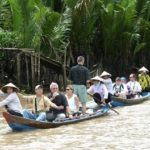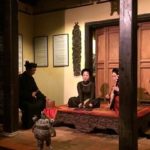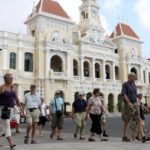Two wards in Hanoi’s Thanh Tri District, namely Dai Ang and Yen My, have recently been recognized as tourist spots after the district’s 14 wards were acknowledged as advanced new-style rural areas, further enriching the city’s tourism offerings.
| Dai Ang Communal House, Dai Ang Ward, Thanh Tri District, Hanoi. Photo: Quoc Hung |
Local authorities are encouraged to adhere to the Tourism Law and its associated regulations when managing tourist attractions, in order to protect and preserve them. This includes taking measures to ensure that public access is maintained and that all amenities are kept in good condition. In addition, authorities should seek to promote the attractions, both locally and nationally, in order to ensure that these important sites are not forgotten and remain viable destinations for visitors.
Exploring the Chain of Spiritual and Experiential Tourism of Dai Ang
Experience the unique cultural traditions, spiritual sites, and breathtaking natural landscapes of Dai Ang with a journey through the chain of spiritual and experiential tourism. From ancient temples to stunning vistas, Dai Ang offers a wide variety of opportunities to explore the spiritual and experiential elements of the region.
Begin your journey by visiting the sacred temple of Dai Ang. This temple is home to the ancient Dai Ang religion and is a special place of worship. The temple provides a peaceful atmosphere to reflect and contemplate the beliefs of the Dai Ang people.
The next stop on your journey is the majestic Dai Ang waterfall. Here, you can take in the breathtaking beauty of the cascading waters and explore the mysteries of the Dai Ang culture.
Continue your journey by visiting the villages of Dai Ang. Here, you can explore the traditional way of life and get a glimpse into the culture of the Dai Ang people. From here, you can also embark on an adventure to the nearby forests and explore the unique ecosystem of the area.
Finally, make your way to the spiritual sites of Dai Ang. These spiritual sites are filled with ancient ruins and artifacts, providing a unique insight into the spiritual world of the Dai Ang people.
The chain of spiritual and experiential tourism of Dai Ang provides a unique opportunity to explore the culture, natural beauty, and spiritual traditions of the region. With its rich culture and history, Dai Ang is a must-visit destination for any traveler.
Dai Ang has been the pride of Thanh Tri District since 2013, when it became one of the first wards of Hanoi to be recognized as a new-style rural area. The distinction has brought with it a number of improvements to the area, including investments in infrastructure, healthcare, and education.
The tourist spot of Dai Ang offers a variety of captivating attractions, including the Dai Ang Communal House, Thien Phuc Pagoda, Nguyet Ang Scholarly Village’s Temple of Literature, Nguyet Ang Communal House, Vinh Thinh Communal House, Thanh Duong Pagoda, Hoanh Son Temple (Vinh Thinh Commune), Linh Linh Shrine (Vinh Trung Commune), Ung Linh Pagoda, and Vinh Trung Communal House. Visiting this remarkable destination, guests can experience an abundance of cultural and religious heritage, making for a memorable and enriching visit.
Among them are nine national-level relics and one city-level relic, which together form an ideal cluster for spiritual and experiential tourism, attracting tourists for sightseeing and exploring the traditional history and culture.
| Dai Ang Traditional Festival 2022. Photo: Quoc Hung |
On the journey in Dai Ang Ward, tourists can also visit the Vinh Thinh conical hat craft village, which is hundreds of years old and a rare gem in the capital city. This craft village is known for its unique conical hat-making techniques that have been passed down through generations. Tourists can watch the experienced craftspeople demonstrate their craft and even buy a souvenir or two to remember their trip.
Besides its traditional features, visitors can experience the innovative American technology-based fish farming model called ‘River in a Pond’ run by Dai Ang Hi-tech Fisheries Cooperative—a proven brand name in clean agriculture. Its products are sold to local markets, supermarkets, companies, and schools and have earned positive customer feedback thanks to successful exports to the US.
Thanks to its cultural-historical charms, Dai Ang Ward has welcomed over 9,600 international and domestic arrivals between 2020 and 2022, generating high economic value and a positive boost to the local economy.
Yen My Commune: An Ecological and Historical Destination
Located in the northern province of Hung Yen, Yen My Commune is a destination rich in both ecological beauty and historical significance. A visit to Yen My allows visitors to explore lush forests, winding rivers, and breathtaking landscapes, as well as ancient pagodas, temples, and tombs.
The commune’s picturesque landscape is a true haven for nature lovers. Its forests are filled with a variety of plants and wildlife, and its rivers are abundant with fish and other aquatic creatures. Yen My also offers many opportunities for outdoor activities such as camping, hiking, and bird-watching.
The area is also home to a number of historical sites, including the Yen My Temple and the Yen My Tomb. The temple is a popular destination for locals and visitors alike, and is home to centuries-old sculptures and murals. The tomb, meanwhile, is an ancient burial site that is said to date back to the 11th century.
From its ecological wonders to its historical sites, Yen My Commune is a destination that truly has something for everyone. Whether you’re looking for a peaceful day in nature or a journey back in time, Yen My is sure to provide an unforgettable experience.
Located along the Red River dyke, approximately 12 kilometers from downtown Hanoi, Yen My countryside is steeped in a rich history, boasting patriotic and revolutionary traditions. When looking north from Dong My Ward or south from Yen So Ward, visitors will be awe-struck by the beautiful panorama of the poetic river landscape of Yen My.
| Yen My Pagoda in Yen My Ward, Thanh Tri District, Hanoi. Photo: My An |
Yen My is home to a village boasting four remarkable relics: a communal house, a pagoda, a goddess temple, and a Dang ancestral shrine. The pagoda-communal house cluster received national-level recognition from the State as a historical-cultural relic in 1995. Moreover, the goddess temple and the Dang ancestral shrine are being proposed for city-level listing. Additionally, the village is home to a temple of literature.
Coming to Yen My, tourists can visit the Yen My Communal House – a historically significant and culturally-spiritual building for both the ancient village and the modern Yen My people. Constructed in 1837, the communal house is situated atop a high, airy mound that offers a favorable terrain. This ancient structure is a must-see for travelers looking to immerse themselves in the local culture of Yen My.
Nearby, Yen My Pagoda – or Thanh Lan Pagoda – is an ancient temple with the Tam Bao (the Three Jewels) altar devoted to Buddha, a goddess altar devoted to three goddesses, especially the sacred stone commonly known as the Bodhisattva Rock or Goddess of Mountains and Forests. Over the years, it has undergone several restorations and embellishments, making it a magnificent sight to behold. In 1995, the pagoda was officially recognized as a national-level historical-cultural relic by the State.
In addition, the ancient Chua Mountain is a long-standing relic complex that features over 200 species of trees, many of which are rare. At the summit sits a sapphire rock, which was brought from Ngu Hanh Son, or Marble Mountains, in the central coastal city of Danang. The rock bears an inscription that tells the story of Chua Mountain.
| A flower road of Yen My Commune, Thanh Tri District, Hanoi. Photo: My An |
The place also has a wide variety of flowers and trees, such as magnolias, orchids, and jasmine. In addition, Yen My offers traditional handicrafts and local dishes, making it a great destination for tourists looking for an authentic experience.
Yen My is a paradise for ecotourism lovers, boasting a variety of captivating attractions, including Hai Dang, Dam Tron, Van An, and Vuon Chim Viet – the first private establishment in the country to be granted a special license to raise rare livestock and poultry species. Here, visitors can admire an array of birds, including peacocks, pheasants, white swans, black swans, and mandarin ducks, as well as animals like camels, ponies, and kangaroos. The place also features a lush landscape of magnolias, orchids, and jasmine, as well as traditional handicrafts and local dishes, providing an authentic and memorable experience.
The two newly-recognized tourist sites will be a crucial precondition for forming tourist routes in the district and cooperation with neighboring localities. Thanh Tri District is determined to become a ‘safe, friendly, quality, and attractive’ destination to meet the requirements of tourism development in the new situation. It is committed to providing visitors with the best possible experience, while also preserving the cultural heritage of the area.
Developing tourism in the Mekong River Delta region
NDO – The Prime Minister has approved the overall planning and a master plan for developing tourism in the Mekong River Delta region until 2020 with a vision extending to 2030.
Ancient house in Ma May
NDO – Ma May, a rare quarter that still retains several old houses, has created one of the characteristics of Hanoi. Hanoi’s streets are becoming increasingly crowded and traditional features can sometimes be hidden behind modern life. But if one takes the time to relax and look around, the ancient features begin to reveal themselves.












